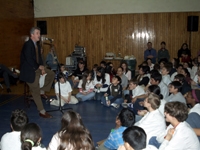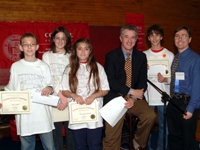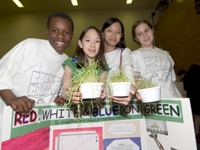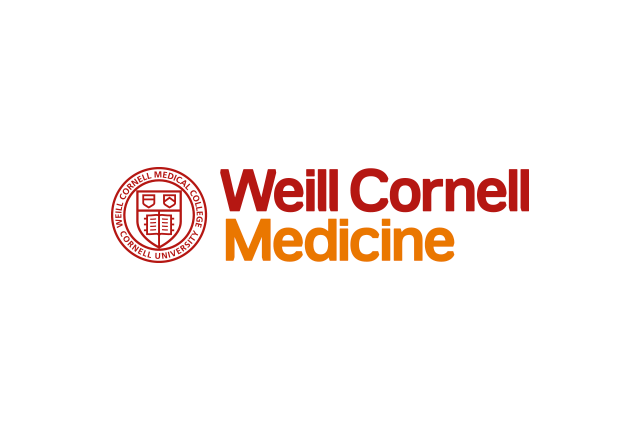How long can french fries possibly last? What's the best way to memorize words? How little sleep can I get away with and still do well in school? Seventh-graders from East Side Middle School made these inquiries the basis of their projects for the Cornell Science Challenge Fair, held on April 5 in Olin Gym. The colorful posters and props were the culmination of three-month projects, carried out with the aid of student, post-doc and faculty mentors from Weill Cornell Graduate School of Medical Sciences, Sloan-Kettering and The Rockefeller University.
This year, teachers at East Side made the scientific method a major focus of their curriculum; in January, 111 students broke into groups of four and five to discover its real-world relevance. The 30 mentors - mostly graduate students, with a few medical students, postdocs and faculty - met with the students once a week over the next three months, guiding them in articulating a hypothesis, designing a procedure and analyzing the results. From procuring petri dishes to interpreting muddled data, mentors were involved in every stage of the experiments, as students applied the scientific method to solve the mysteries of their universe.

Dr. Max Gomez of NBC commanded complete attention as he announced the winners of the 2005 Cornell Science Challenge.

Marek Klepaldo, Margot Allison, Marie-Camille Arruntegui and Alec Montgomery accept a Best Presentation award for their project, titled "How Does Fear Affect Heart Rate?"
During the fair, now in its eighth consecutive year, students scurried around the gym, chiming in on group presentations and checking out their friends' displays along with their mentors, teachers, and parents. Judging the fair were graduate students, post-docs, and "junior judges," the previous year's winners. Judging the fair were graduate students, post-docs, and "junior judges," the previous year's Best Science winners. Grad students also opened their labs for touring at Weill, Sloan-Kettering and Rockefeller.

Andre Spence, Laura Urciuoli, Kristen Sheih, and Ariana King present plants grown under red, white, and blue light.
Asif Maroof, a first-year graduate student in neuroscience, helped his group design the "Sleepless in New York" experiment to evaluate the hazards of sleep deprivation. "They formed the project around their own interests; none had slept enough the night before, and they felt their memory and energy were affected," said Maroof.
An "Attack of the Germs" display laid bare the grimy truth of city transit, with intrepid field researchers swiping bus, tram and subway poles to expose invisible fungi. At an age when some still shriek about cooties, these students make clear the evolution of knowledge through science. In a presentation titled "Eye C Better," students fed carotene-rich vegetables to their classmates and tested their vision on an eye chart. Everyone's eyes improved over the course of weeks.
At the day's conclusion, Dr. Max Gomez, medical reporter for New York's NewsChannel4 (NBC) and a former postdoctoral fellow at Rockefeller, announced the winning groups in the categories of "People's Choice," "Most Creative Idea," "Best Presentation" and "Best Science." Winners and runner-ups received gift cards to Barnes & Noble.

Judges Michael Bruno, Michelle Tourigny, and Alicia Reid (l-r) sorted through awards and certificates for the lucky winners.
2005 Cornell Science Challenge Winners
Best Presentation - "French Fries: The Scientific Exploration"
Best Presentation (Runner-Up) - "The Grass Is Actually Greener on the Red and Violet Sides"
Most Creative - "Humpty Dumpty vs. Soda"
Most Creative (Runner-Up) - "Sleepless in New York"
Best Science - "Memory Helpers: Which Is Best?" (writing, listening, recitation)
Best Science (Runner-Up) - "Memory's Favorite Color"
People's Choice - "Attack of the Germs"
Junior Judges Award - "Soil and the City"
Photos by Amelia Panico.

